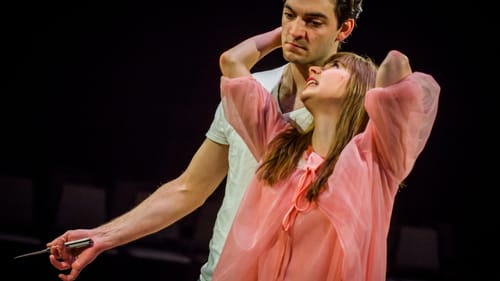Stay in the Loop
BSR publishes on a weekly schedule, with an email newsletter every Wednesday and Thursday morning. There’s no paywall, and subscribing is always free.
Nothing to pity
Philadelphia Artists’ Collective presents John Ford’s ‘Tis Pity She’s a Whore’

Very little in theater approaches the thrill of a revenge tragedy done rippingly right. For proof, head over to the Philadelphia Boys Choir and Chorale, where the Philadelphia Artists’ Collective (PAC) presents a pulse-pounding production of John Ford’s ‘Tis Pity She’s a Whore.
Director Jessica Bedford and company offer a clear-eyed, lucid interpretation of this thorny Jacobean drama that balances the text’s somewhat outrageous plot elements with a keen grasp of its poetry. All the elements you expect from the genre are on display—trust me, there will be blood, and lots of it—but in this interpretation, nothing feels gratuitous or shocking for its own sake. When I tell you a bit about the plot, you’ll realize what a feat that is.
An unholy union
PAC’s press materials describe Ford’s best-known work—a smash hit in its day, but now rarely staged—as almost an incestuous Romeo and Juliet. That’s fair, to a degree, but smooching siblings Giovanni (Trevor Fayle) and Annabella (Stephanie Hodge) make Shakespeare’s star-crossed lovers seem downright milquetoast. Their unholy union precipitates a body count Quentin Tarantino would envy.
Ford shows a mastery of intricate plotting, and Bedford’s production handles each delicate strand with absolute clarity. Those who fear getting lost in a parade of arcane language when they encounter classical drama should feel no trepidation here—the narrative is vibrant and engrossing. Dustin Pettegrew’s immersive set, which turns the second floor of Boys Choir into an octagonal playing area with action happening in all corners, aids in building connection between the audience and the material.
So does the original music, composed by cast member Josh Totora (who also offers bumbling comic relief in the form of Bergetto, a hapless potential suitor for Annabella), and Eli Lynn’s elegantly choreographed fight design. Design elements fire on all cylinders: Millie Hiibel’s costumes sharply demarcate characters and communicate their motives, and James Lewis’s lighting design makes effective use of a nontraditional performance space while delivering the spectral, shadowy mood the piece so urgently needs.
What does it mean to be a woman?
In her director’s note, Bedford identifies as a core theme the realities of women existing in a world not designed with their wants and needs in mind. “What does it mean to be a woman in a world dictated by men’s tempers and desires?” she asks—a question her staging answers without employing any extraordinary measures to update the text or draw overt parallels to contemporary life. We certainly see the lack of agency in Annabella’s experience being regarded as an object of lust or potential property. But it’s also evident in the form of Hippolita (a striking Annette Kaplafka), a widow left with few options, and the handmaid Putana (Ebony Pullum, deeply compelling), whose devotion to Annabella causes her unjust suffering.

Annabella undeniably bears the brunt of male caprice, a fact that becomes more evident as Hodge’s spellbinding performance progresses. When Giovanni professes his love, she answers him meekly: “Thou hast won the field and never fought.”
Love as conquest
Certainly, the incestuous nature of their relationship dominates an audience’s reaction. But we’re meant to see beyond it, to the point that any romantic relationship could be perceived as a conquering act. That simple fact resonates as Annabella enters into a loveless marriage with the wealthy Soranzo (David Pica, appropriately slimy)—and ultimately when she realizes her grim fate. Hodge allows Annabella to remain dignified, no matter the inequalities that befall her.
Fayle’s Giovanni—spiteful, garrulous, and unpredictable—makes a perfect foil to Hodge’s strong-willed characterization. Together, they even manage to make the most unjustifiable couple since Oedipus and Jocasta seem sympathetic from time to time. Strong work in the ensemble also comes from PAC regulars Nathan Foley, John Lopes, and Monroe Barrick, as well as newcomers Abdul Sesay and Eric Mills.
Several centuries after its debut, Ford’s tragedy still shocks and titillates. Easily the best classical theater production I’ve encountered since moving to Philadelphia, PAC’s ‘Tis Pity also ranks among the strongest assumptions in this genre I’ve seen anywhere.
What, When, Where
‘Tis Pity She’s a Whore. By John Ford, Jessica Bedford directed. Philadelphia Artists’ Collective. Through April 13, 2019, at the Philadelphia Boys Choir & Chorale, 1336 Spring Garden Street, Philadelphia. (267) 521-2210 or philartistscollective.org.
‘Tis Pity She’s a Whore is performed on the second floor of Philadelphia Boys Choir & Chorale, which is accessible only by stairs.
Sign up for our newsletter
All of the week's new articles, all in one place. Sign up for the free weekly BSR newsletters, and don't miss a conversation.

 Cameron Kelsall
Cameron Kelsall